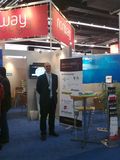The battle continues… I can still remember, it must have been 5 or 6 years ago when there was a big debate over which system would win, UMTS or Wi-Fi. It was a strange debate, as even then it was clear that Wi-Fi aimed at homes and hotspots while UMTS aimed for wide area coverage. The whole municipal Wi-fi wave only came and went a couple of years later. Today, Wi-Fi is used ubiquitously in homes and as far as the Wi-Fi hotspots in Europe and elsewhere go, they are held mostly alive by high roaming charges and better coverage where no 3G in-house coverage is available. Also, there are some niche opportunities like for example in trains. I'd say it's a peaceful co-existence today.
As mobile networks are getting more and more traffic these days, the discussion seems to stir up again, this time against the background of whether UMTS femtos or Wi-Fi is better for 3G macro network offloading. In the end, I'm sure peaceful co-existence will prevail. Once femots are nicely integrated together with today's Wi-Fi access points that include an access device (think DSL, coax or fiber modem), the re-merger of fixed and wireless network operators will open the door to femto acceptance in homes. And as far as public hotspots are concerned I think combined devices also make the most sense, especially if the Wi-Fi hotspot operator is also a UMTS network operator.
So even in this area, I see a peaceful coexistence for both technologies in the long run.



